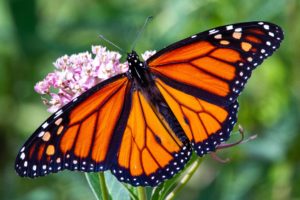The Monarch Butterfly
With the arrival of Pollinator Week, we aim to celebrate and share the importance of the pollinators that support and stabilize our entire ecosystem. For this post, we’d like to spotlight the monarch butterfly!

A monarch butterfly.
Monarch butterflies contribute to healthy soil through their pollination — which helps to foster booming plant communities — and they serve as an important food source for birds, insects, and other small animals. One of the most recognizable butterflies species, the Monarch is known for its yellow, black, and white bands; they also reach up to two inches before their metamorphosis. Sensitive to temperature changes and preferring a warm climate, they are also known for migrating each year, flying across both the United States, Canada, and Mexico despite the challenges of climate change.
Fun fact: Monarch butterflies can use their fat reserves if the outside temperature is too low!
Although they have faced trouble to a dwindling population, recent studies have shown that monarch populations have been increasing during summer seasons in North America. One of the plants that are most responsible for their resurgence is the milkweed! Milkweed is a host plant for caterpillars of the monarch butterfly and plays a critical role in their life cycle.
For more information and news on the monarch butterfly, visit these web pages below:
- World Wildlife Fund: “Monarch Butterfly”
- NBC News: “Monarch Butterfly Populations May Be More Stable Than Previously Thought”
- UGA Today: “Monarch Butterfly Populations Are Thriving in North America”
- The New York Times: “Some Monarch Butterfly Populations Are Rising. Is It Enough to Save Them?”
To learn how to expand your garden and incorporate plants such as milkweed, visit our Home Gardens page.
Long live the monarch butterfly!
